From Horse Power to Horsepower
Vehicles in Yellowstone
Yellowstone is well known as having the world’s highest concentration of thermal features and as one of the most intact ecosystems on the planet. It has geysers, hot springs, and mud pots; bison, wolves, and bears; elk, mountain lions, and eagles; and more than 100 waterfalls.
But just as diverse as these natural wonders are the vehicles for getting around to see them. You can tour via motorboats, stagecoaches, cars, buses, automated electric buses, snowcoaches, and more. Here’s a guide to the vehicle options for park visitors.
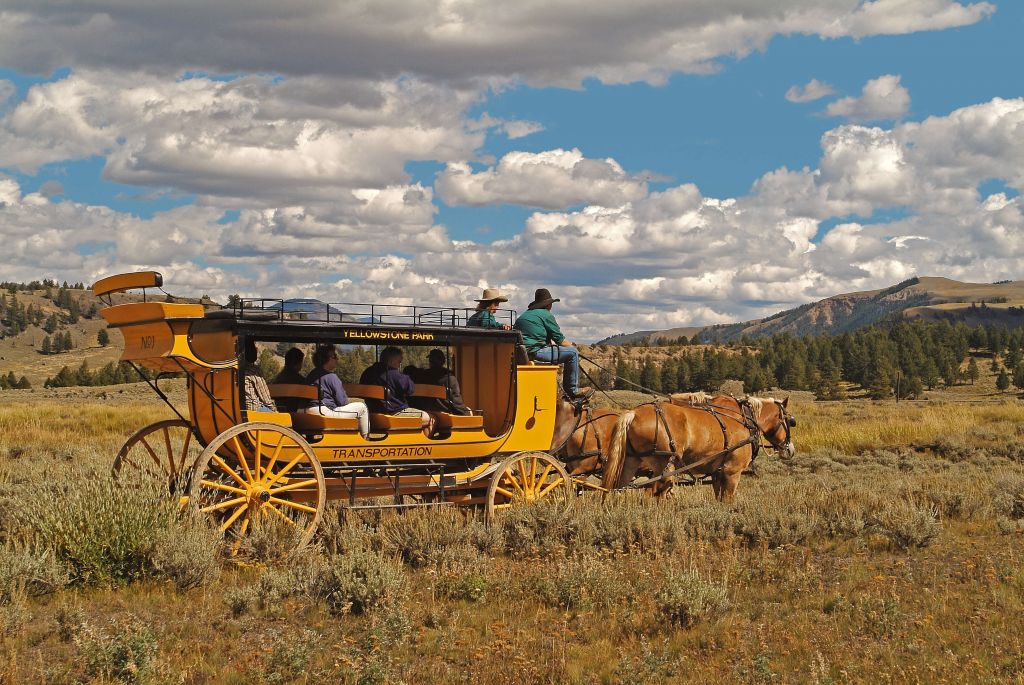 Stagecoaches
Stagecoaches
The three wagons used for the scenic covered wagon tours from Roosevelt Lodge today are almost exact replicas of the six-horse “Tally-Ho” stagecoaches manufactured by the Abbot-Downing Company. The original coaches transported park visitors from the train depot at Gardiner to the hotel at Mammoth until stagecoaches were banned in 1917. “When I started working in the park in 1980, we were using the original stagecoaches for the scenic tours,” says Leslie Quinn, who has worked in the transportation department of Xanterra, the park’s concessionaire, for 41 years. Todd Scott, the Director of Support Services and Activities for Yellowstone National Park Lodges who is in charge of fleet acquisition, says, “Eventually they became too valuable to be running on tours. They’re now at the national park’s archives.”
The stagecoaches used today differ from the original ones because they have hydraulic brakes hidden behind the wheels and don’t offer seats on the coach’s roof. “It was decided that seats on the roof weren’t particularly safe,” Quinn says. Because today’s 2-hour scenic stagecoach rides are on a flat, well-maintained track from Roosevelt Lodge into Pleasant Valley, only two draft horses (instead of six) are used. “We don’t have anyone who can drive a six-up hitch. There aren’t that many people around anymore who can drive one,” Quinn says. “If you’re one of those rare people, you’ll get some calls from Hollywood whenever there’s a Western movie being made.”
Almost as interesting as taking a scenic ride is watching the YouTube channel of Dave Engel, the Joliet, Mont.-based wheelwright who keeps the wheels of the three replica Tally-Ho wagons rolling. The wheels have wooden spokes with a metal rim around the outside. “Dave does all of the repair work on them,” Scott says.
From Roosevelt Lodge you can also take a horse-drawn vehicle to a dinner cookout. “These are different than what we use for the scenic rides,” Quinn says. “We call these ‘church wagons’ because the rows of benches inside look like church pews.”
Fun fact: Two of the biggest stagecoach robberies of the 20th century in terms of the number of people (174 and 165, respectively) and stagecoaches robbed (17 and 25) happened in Yellowstone in 1908 and 1914. The 1908 robber and the $2,000 of cash and valuables he got away with were never found. The 1914 robber was caught with almost $1,000 in cash and jewelry. The last stagecoach robbery in the park was in 1915.
 Cars
Cars
While other national parks began allowing cars in 1908, Yellowstone didn’t until Aug. 1, 1915, and this was only after several years of heated debate. It was conjectured that the 2,000 horses used to pull the stagecoaches that had been taking visitors around the park since its founding in 1872 would be spooked by cars. And that is exactly what happened. But it was cars and not stagecoaches that won out. Horses and automobiles only shared Yellowstone’s roads for two seasons. Cars were such a boon to Yellowstone tourism that stagecoaches were banned in 1917.
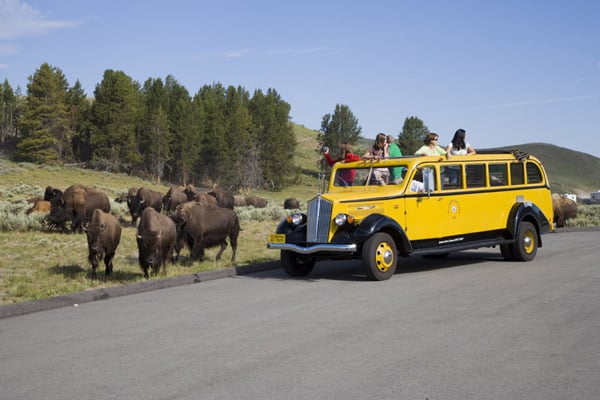 Buses
Buses
Next came buses. The White Motor Company built several models of touring buses for the park. By the 1920s, there were more than 300 11-passenger and seven-passenger vehicles in the park’s touring fleet and the park concessionaire bragged it “had a bus for every day of the year.” The concessionaire eventually amassed the world’s second largest bus transportation system (after Greyhound).
Eight of the White Motor Company’s 1936 Model 706 touring buses are still used on tours today. “The park originally had 98 of them,” Quinn says. “It’s funny what can happen to vehicles. They have to go through a period of being old junk to arrive at a period of being incredibly cool antiques.” Starting in the 1950s, the park’s tour company began selling the Model 706s off. “You could get one for $300 or $400 Quinn says. “But then in the late 1990s/early 2000s we got the chance to buy eight of them back for $40,000 each. At the time it was thought we got a bargain.” The Xanterra-managed Yellowstone National Parks Lodges then spent about $250,000 refurbishing each of the 706s. Today these Historic Yellow Buses, which have roll-back canvas tops, are used on different driving and photography tours. “They are charming, charming vehicles,” Quinn says. “It’s possible for private parties to rent one [with a driver-guide] for the day, too.”
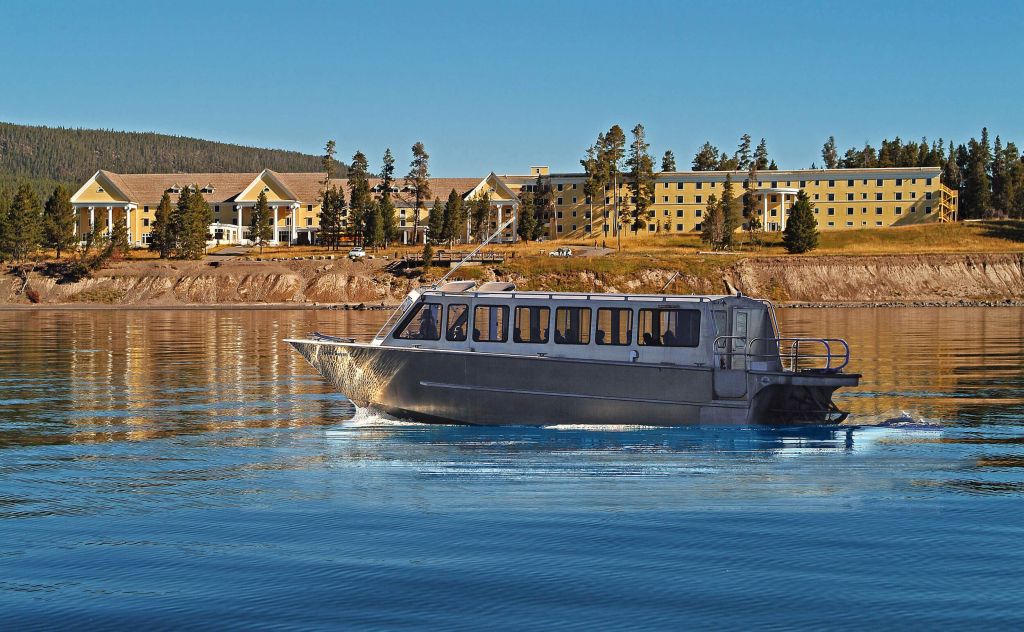 Watercraft
Watercraft
“It’s more difficult to keep historic boats safe for people than it is historic cars and buses, so we keep our fleet pretty current,” Quinn says. The Lake Queen II has been taking visitors out on one-hour scenic cruises of Yellowstone Lake since 1994.
This summer there is something new in the fleet of motorized rental boats. “We’ve been waiting about three years for the delivery of an electric outboard motor to test on one of our rental boats,” Scott says. It is scheduled to arrive later this summer. “We’re not sure how it will do, but we’re excited to try it out. It’s a different experience than a gas-powered boat motor. With the electric motor, all you really hear is water hitting the hull,” Scott says. The motor is about 40 horsepower and will be tested on one of the 23 18-foot aluminum boats in the rental fleet at Bridge Bay Marina. “The electric motor does have some drawbacks. You go and fill up the gas tank on a traditional motor and you can run around all day. The electric motor has a more limited range. Depending on the conditions on the lake and what they’re doing, it will last between 2 and 4 hours,” Scott says. “But I think some people will think the quiet is worth it.”
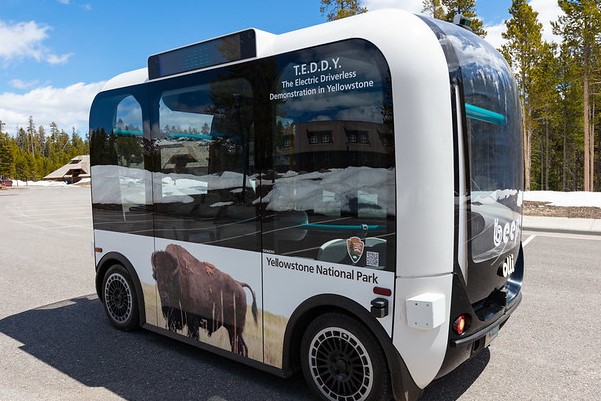 Automated Electric Shuttles
Automated Electric Shuttles
Through Aug. 31, Yellowstone is testing electric, driverless mini-buses on two routes around Canyon Village. Called TEDDY for “The Electric Driverless Demonstration in Yellowstone,” the pilot program includes two shuttles operating seven days a week. The shuttles are first-come, first-served and run in 3-hour shifts. At the end of a shift, they are charged for 2.5 hours. Rides start at 7 a.m. and end at 9 p.m. “The purpose of this deployment is to test the technology in a national park,” Yellowstone Visitor Use Management Coordinator Christina White told the Jackson Hole News&Guide. “Our goal is to learn as much as we can,” she said, “and apply the lessons in national parks in the future.”
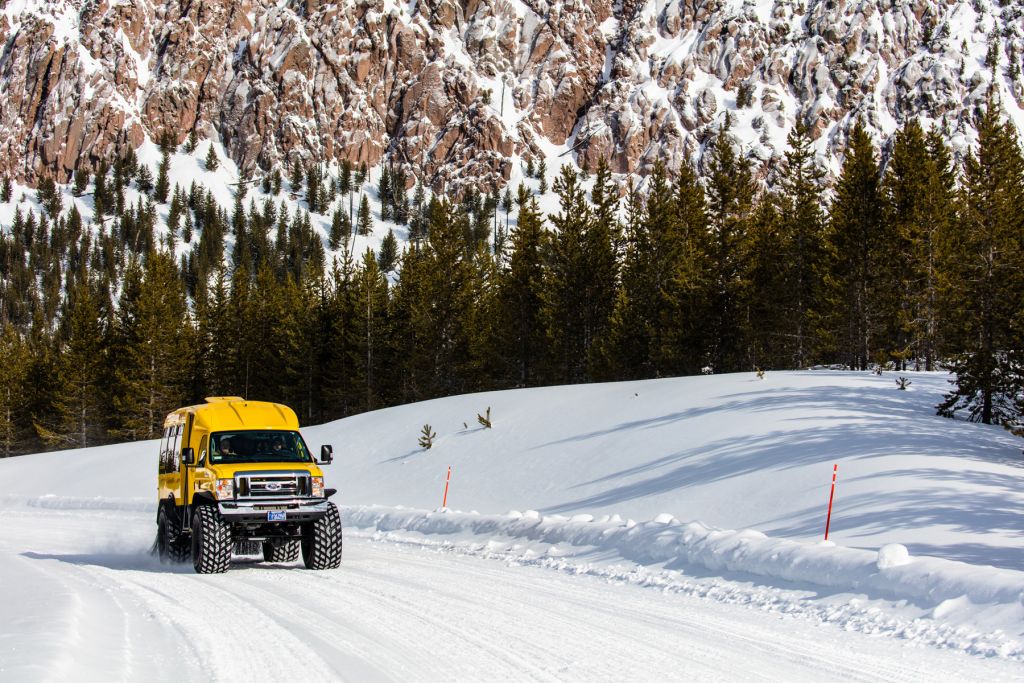 Snowcoaches
Snowcoaches
A fleet of 33 snowcoaches travel Yellowstone’s snow-packed roads in winter, offering a variety of scenic tours. The Turtle Top Vanterras sit on a Ford E350 chassis and roll with Michelin CargoXBIB tires which are most commonly used on heavy-duty agricultural equipment. They work great during Yellowstone’s winter because of their size and the low pressure they run on. “They just float on the snow,” Quinn says. “It’s a little hard if we get dumped on with two or three feet of snow, but a few inches, they don’t care.” Quinn says, “When you’re out in one of these on a snow road and it’s just your group — it is such a great experience to get into the park interior with these.”
Yellowstone Historic Vehicle Collection
Containing 30 historic horse-drawn and motorized vehicles used in the park since its founding, Yellowstone’s historic vehicle collection is not open to the public. (The collection is currently in a storage facility in Gardiner, Mont., and the park hopes that a more suitable storage/exhibit facility will eventually be constructed; as of now there is no budget allocated for this, though.) The collection is among the largest vehicle collections in the National Park Service. While you can’t see it, the Discovery Channel included a segment about it in its film “Hidden Yellowstone,” which is available to stream on Discovery Plus.
Written by: Dina Mishev
Dina Mishev is a freelance writer based in Jackson Hole, Wyo.
Read More
- Read More